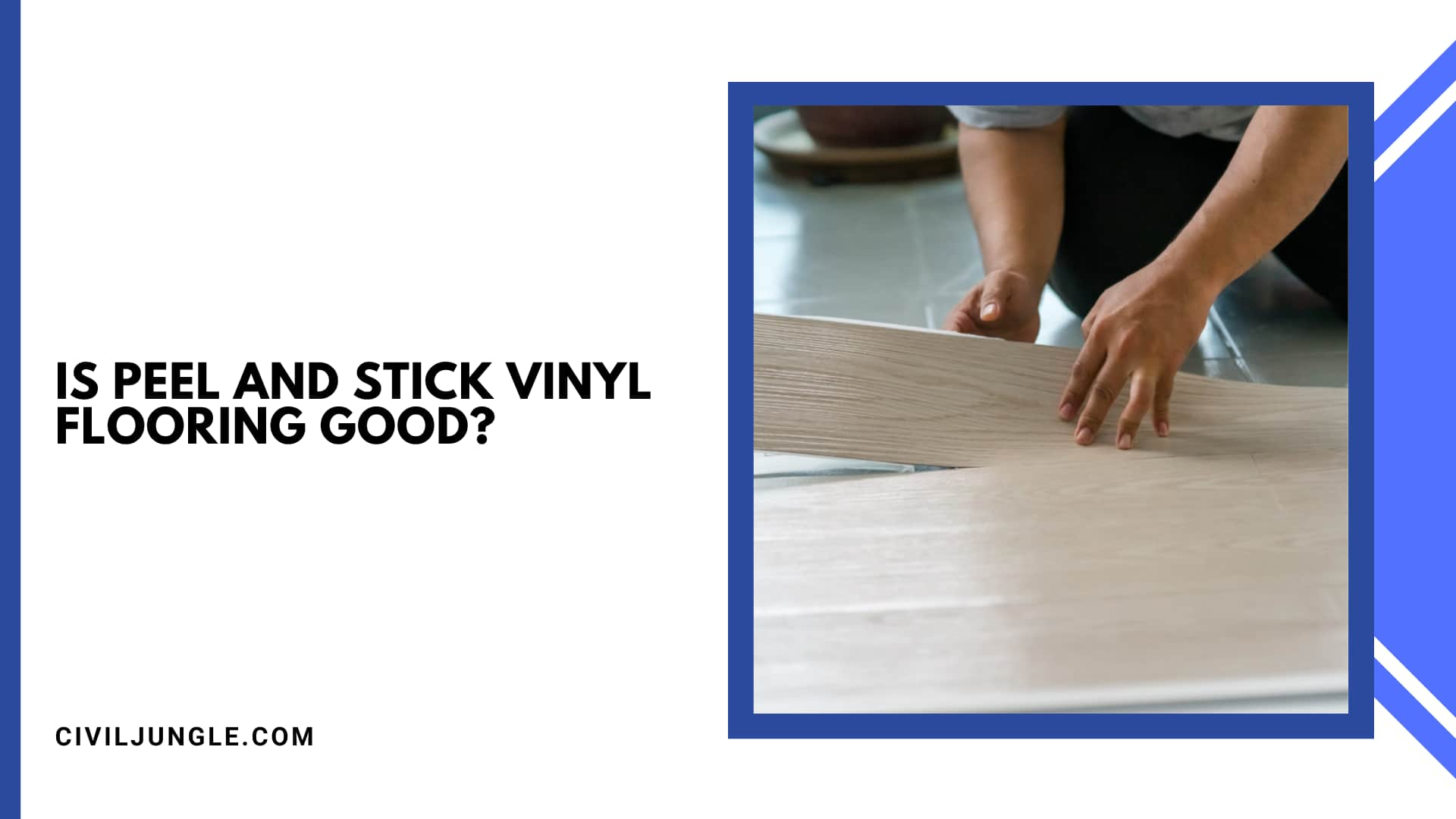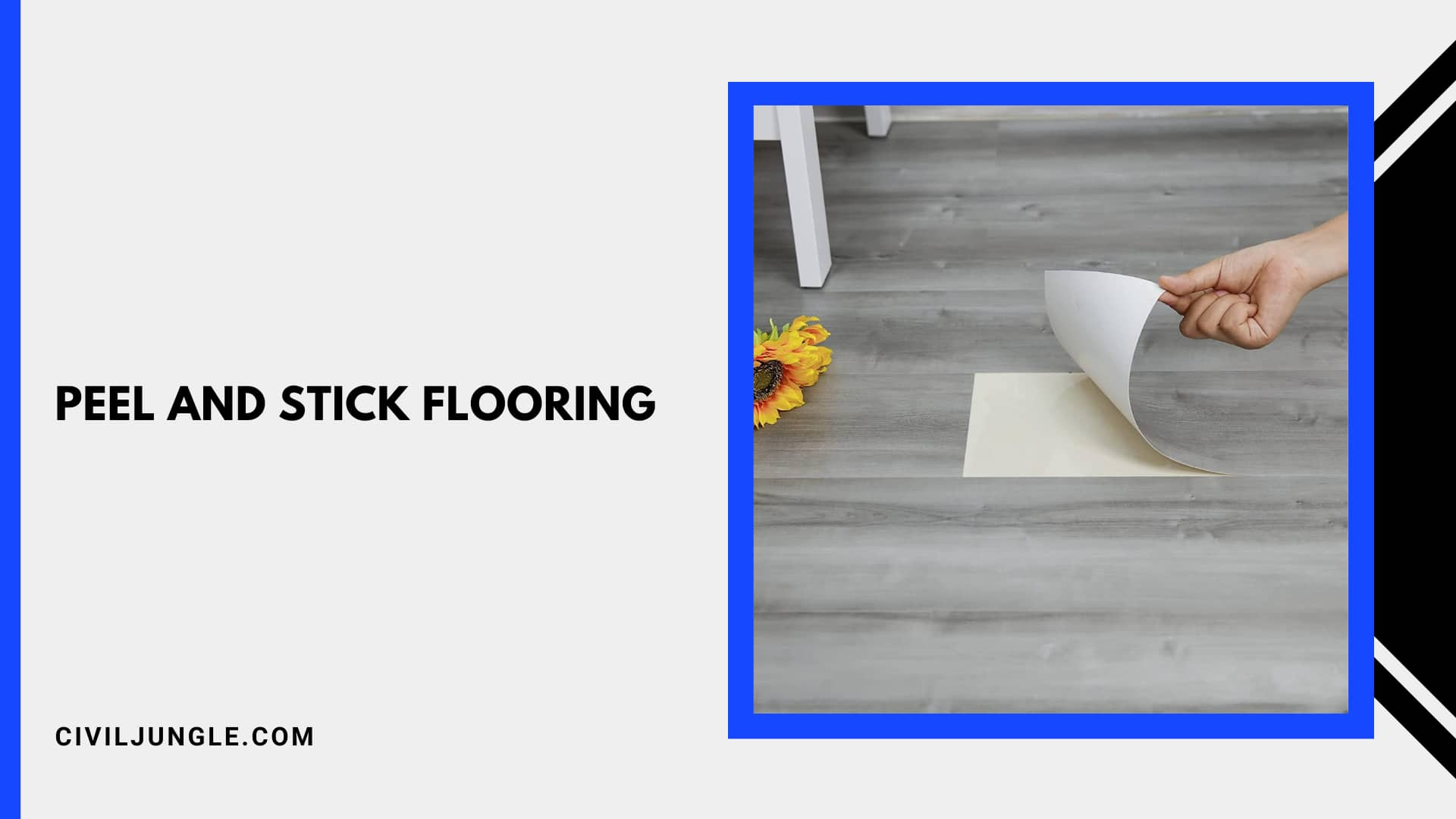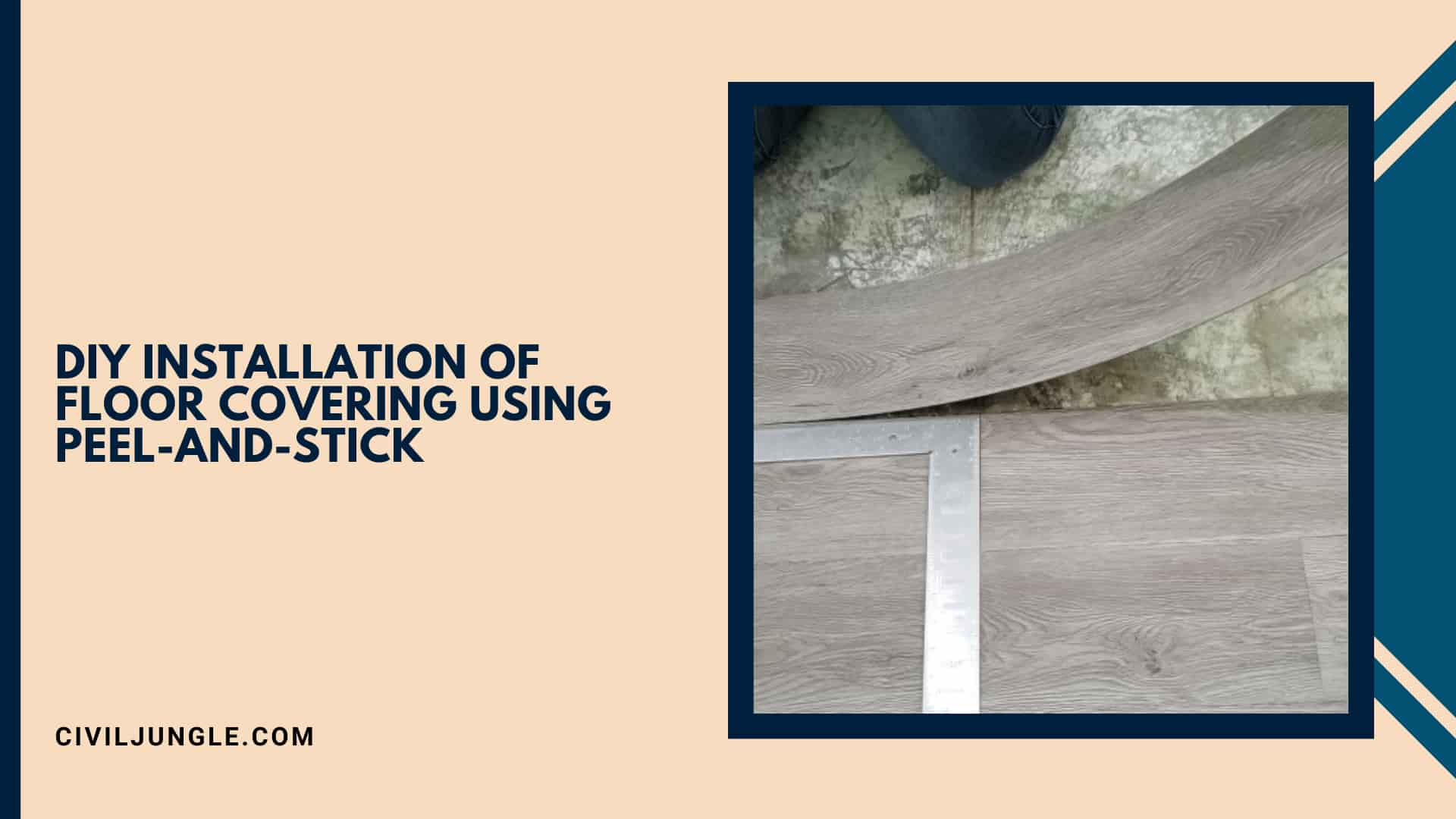What Is Peel and Stick Flooring?
Important Point
Peel and stick flooring, often referred to as self adhesive floor tiles or self adhesive vinyl floor tiles, is also popularly known as adhesive or removable flooring.
It is basically a simple wood flooring that is very easy to install, and it is made from wood or tile made of vinyl.
Various options are available in the market, from a high gloss finish to flat and scratch-proof.
The peel-and-stick flooring name to the floor itself suggests its meaning that it is a type of flooring that directly sticks to the floor for fast and easy installation.
Peel and stick vinyl comes in a variety of styles and colors. Vinyl is the primary material used in most “peel and sticks” tiles.
Also Read: Best 24 Kitchen Floor Tile Ideas 2024
Peel and Stick Flooring – Ultimate Guide
It’s time to start thinking about style after you’ve decided on the type of peel-and-stick vinyl tile you prefer. We won’t spend much time here because of the wide variety of tastes.
Almost anyone can find a color or pattern they like, even if they’ve always wanted hardwood flooring.
A wood-look tile is a popular and easy-to-find design trend. If parquet or planks are what you want, the stone is a far more realistic option, and it looks fantastic when grouted.
If you look hard enough, you may find everything from a snowy white to a raspberry-hued yellow or any other color you can think of.
You can easily remove and reinstall this type of vinyl tile if you decide to change your mind.
Even though this gives you more flexibility than a permanent floor, you should still carefully plan your décor and furnishings before installing this type of flooring.
It’s just like a conventional peel-and-stick vinyl tile, but a VCT or vinyl composition tile adds an extra level of robustness.
They’re expensive, simple to replace, and quick to set up, but they’re still a great value.
You may want to consider a VET tile if you are looking for something even more durable. The E stands for enhanced in VET because these tiles are more durable and resistant to abrasion. They can be tougher to locate or could be grouped in with VCT tiles depending on where you purchase.
In terms of quality and longevity, solid vinyl tiles (abbreviated SVT) are the next logical step forward. More commonly found in commercial settings, these tiles don’t have the same variety of colors and designs as VCT tiles, but they require less upkeep.
However, they are more expensive than their composite counterparts, making them unsuitable for high-traffic locations.
Edges are the only other consideration when it comes to vinyl tile varieties.
Groutable vinyl tile flooring that looks like stone is an alternative to the standard tile profile options, offering a more contract vinyl floor tiles look.
Although it provides an added level of realism to your floor, this specialty tile is just as simple to set up.
1. Wear Layer
The wear layer of your bathroom floor tile is crucial, whether you choose marble tiles that look like they belong in ancient Greece or textured tile.
This is the only thing preventing structural breakdown from occurring, and it varies as much as you might imagine.
2. Peel and Stick Flooring Materials
The vinyl used in peel-and-stick flooring, sometimes known as adhesive floor tiles, is between 0.3 and 0.5 mm thick.
Colors and textures are available, and they can even be made to resemble real wood.
Some even opt for groutable vinyl tile or high gloss laminate flooring for a more refined look. For the time being, peel-and-stick wood look.
Flooring is the rage, but stone tiles and intricately designed tiles are also popular options today.
Peel and stick wall tiles are a common occurrence.
Also Read: Best 34 Vinyl Kitchen Flooring Ideas
3. Peel and Stick Flooring Vs Other Flooring Types
There are three main differences between peel-and-stick flooring and other types of flooring: cost, installation, and longevity.
4. Cost
For a low-cost solution, peel-and-stick flooring is a popular choice.
Hardwood flooring costs $5 to $12 per square foot, while carpet costs $0.50 to $2 per square foot on average.
If you do it yourself, you’ll also save money on installation.
5. Installation
Vinyl stick flooring does not require an underlayment like other forms of flooring.
Peel and stick flooring can be installed on virtually any level, solid surfaces, such as concrete or subflooring. Padding is required beneath carpets.
6. Longevity
In comparison to other flooring solutions, peel and stick don’t hold up as well over time. According to Chapman.
if you choose a high-quality product, you may expect it to last up to 25 years under perfect conditions.
Hardwood, on the other hand, has a much longer service life.
Also Read: Best 16 Kitchen Flooring Ideas 2024
DIY Installation of Floor Covering using Peel-and-Stick
Installing peel-and-stick flooring is a simple DIY task.
That’s what makes it so appealing. You’ll need a tape measure, putty knife, pencil, clear ruler (or straightedge), utility knife, scrap wood, hammer, and stepladder to install it,
Installation Tips for Peel and Stick Flooring
Following are some of the installation tips that you should follow
- With a clean, dry room, begin
- Work your way outwards from the center of the room.
- Even space flooring panels use spacers.
- When two pieces come together, make sure they blend seamlessly.
- The process of setting up this system couldn’t be any easier:
Removal of Peel and Stick Flooring
Peel and stick flooring can also be removed by the homeowner. This may be more difficult depending on the type of floor.
Use adhesive remover, putty knives, a pry bar, and pliers to remove the peel-and-stick flooring.
It doesn’t matter what tools you use; the removal process is the same.
You can remove a tile by getting under the edge, prying it off, and then doing the same for the next tile.
Consider consulting the manufacturer to check that the glue is lead-free and does not include urea-formaldehyde, which can generate harsh smells.
Pros and Cons of Peel and Stick Wood Flooring
Pros of Peel and Stick Wood Flooring
1. Budget-Friendly
Peel and stick wood flooring’s cost is a significant plus. Even on the “luxury” end of peel and stick, the price per square foot is somewhere between $2 and $5.
When it comes to hardwood flooring, that’s a tiny percentage of the cost.
Homeowners who might have previously dismissed the idea of redoing their floors due to the expense may now find themselves in unfamiliar territory.
2. All-Weather Resistance Option
Some people may prefer peel-and-stick flooring to wood since it does not expand and contract in response to temperature changes.
Temperature concerns can cause warping and crack in the wood and ceramic tile.
Peel and stick can withstand changing temperatures.
3. Easy Installation
It’s not out of the question to complete a project in hours, depending on the region’s size. Aside from the tile, only a few more items will need to be acquired.
Most of the instruments needed for an installation may be found in your home, including a utility knife, a tape measure, and some tape to designate the center of the room.
Only a press for weighing the tile down to ensure it properly adheres is suggested after that.
And it’s a rental item that may be returned at the end of the month.
Peel and stick flooring may be installed in a matter of minutes by following these simple instructions:
- You should do this to ensure that your tiles are properly acclimated to the room’s temperature before installing them.
- Dirt and debris will interfere with proper tile adhesion if the floor is dirty or soiled.
Tape a “X” in the middle of the room, and you’re done. Your peel-and-stick journey begins here. - Tiles should be laid down in the pattern you intend to use. You’ll save a lot of time and effort this way.
- It’s up to you how far you want to go. At the very least, till you’ve completed the space. You’ll need to chop them down to size to You’ll need to chop them down to size to make room for the tiles that don’t quite line u. But other than pushing the tiles down, peel-and-stick installation is essentially a one-step process.
4. Appearance
Thanks to today’s cutting-edge peel-and-stick designs, including the best vinyl flooring options, you can find a peel-and-stick design to match your home’s style.
Using peel and stick is a great way to create a wide range of designs, from wacky geometric patterns to a wood-like look.
Also Read: Best 14 Kitchen Floor Ideas on a Budget
Cons of Peel and Stick Wood Flooring
1. You Get What You Paid For.
Peel and stick flooring is no exception to the general rule that quality suffers when you pay less for something.
The higher the tile’s thickness, the higher it is quality.
As a result, the final cost will be higher. That’s a wide range of thickness, from 2 mm to more than 8 mm.
It’s also possible that they’re less durable because of their lower quality.
You may expect low wear and tear and a long lifespan if you take good care of them, but you will have to be more careful with them than you would with other types of flooring.
2. Factors Involved in the Subflooring.
It’s possible to peel and stick on existing flooring, but you can’t use it if there are any issues with that flooring.
Choosing a peel-and-stick solution isn’t necessarily a negative thing, but if it wasn’t budgeted for this job, you might have taken on more than you can handle
3. To Increase the Value of Your Home, You Need to Look Somewhere Else.
Peel and stick wood flooring is not a long-term investment in your home’s worth, as is the case with hardwood.
Although this flooring option is more widely recognized than in the past, you’re unlikely to hear a potential buyer include it on their list of must-haves. Naturally, real wood floors are more likely to elicit that emotion.
4. You’ll Have to Pay for It Because You Won’t Be Going Greet.
Peel and stick flooring doesn’t help the environment at a time when many people are concerned about their carbon footprint.
When this flooring is thrown away, it will remain in a landfill for thousands of years because of its composition.
Not a fantastic selling point for this flooring selection!
Does Peel-And-Stick Flooring Last?
There is a wide range of life expectancies for peel-and-stick flooring.
Peel and stick floors can endure anywhere from five to twenty-five years.
However, how properly they’re installed, how much traffic they receive, and whether they’re constantly exposed to water all play a role in how long they last.
Though some products are permitted for use in high-moisture regions, you may get better performance out of your flooring if you steer clear of those locations.)
Before applying the peel-and-stick planks, the flooring must be in good condition and entirely level.
It’s possible to get a lot more life out of your flooring if it’s done correctly in a less-frequently used region, but even if it’s installed poorly, you may expect to get many more years of use out of your flooring if it’s installed correctly.
It’s better to utilize this flooring as a short-term fix. If you need a short-term solution or don’t want to spend a lot of money, peel-and-stick flooring is the best option for you.
The material is actually quite durable and fairly water-resistant.” “In a kid’s room, for example, or a multi-purpose room, I think they’re a terrific option.
Due to their ease of installation and removal, you can utilize these vinyl tiles while your children are little and then upgrade to a more sophisticated playroom later on.”
A guest room, the laundry room, or even a walk-in closet could benefit from peel-and-stick flooring.
In contrast, Day advises avoiding high-volume spaces, such as the living room or an entryway, as well as “splash zones,”
such as bathrooms and kitchens, which are frequently used.
Vinyl plank flooring isn’t for everyone, but some individuals have had a pleasant experience with it in their homes.
Like this post? Share it with your friends!
Suggested Read –
- What Is Plum Concrete?
- Type of Building Materials
- What Is Composite Roofing
- What Is the Best Laminate Flooring?
- What Is the Best Conservatory Roof Type & Material?
What Is Peel and Stick Flooring?
Peel and stick flooring, also known as self-adhesive floor tiles, is a type of flooring that is easy to install and made from vinyl or wood. The flooring has an adhesive backing, allowing it to stick directly to the subfloor for a quick and hassle-free installation.
What Materials Are Used in Peel and Stick Flooring?
Most peel and stick flooring is made from vinyl, which comes in various styles and colors. Some options mimic the appearance of wood or stone and come with different finishes, such as high gloss or matte.
How Durable Is Peel and Stick Flooring?
The durability of peel and stick flooring varies. High-quality options can last up to 25 years under ideal conditions. However, this type of flooring is generally less durable compared to traditional hardwood or tile.
How Do I Install Peel and Stick Flooring?
Installation is straightforward. You need a clean, dry subfloor. Measure and cut the tiles to fit, peel off the backing, and press the tiles onto the floor. Ensure the tiles are well-aligned and use a roller to secure them.
Do I Need Any Special Tools for Installation?
Basic tools required include a tape measure, utility knife, putty knife, straightedge, and a roller to press the tiles down.




Leave a Reply